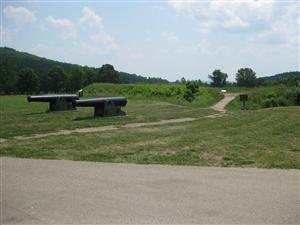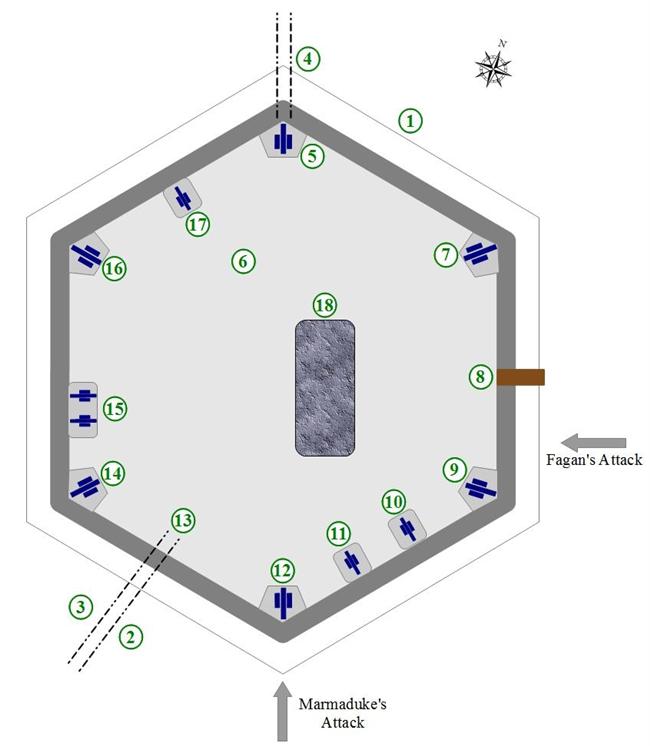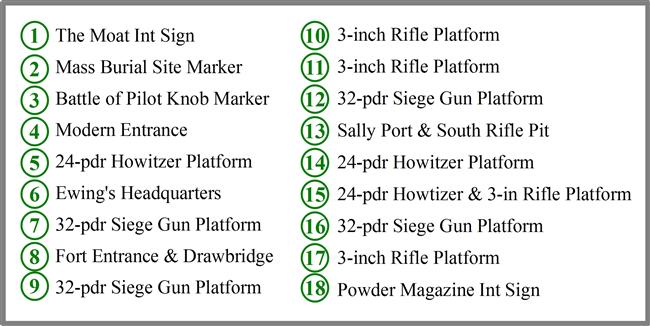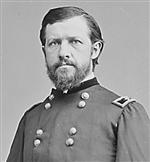Tour Stop


Directions: What remains of Fort Davidson [ Waypoint = N37 37.229 W90 38.421 ] is located on the Fort Davidson State Historic Site. But instead of going back to the Visitor Center, we will go to a parking area closer to the fort itself.
- When you leave the parking area for the Iron Furnace Historical Marker, turn right onto State Highway 221.
- After about 0.3 miles, turn left at the Stop sign onto Main Street.
- You should see the large Fort Davidson Historical Marker just ahead on the left.
- Pull into the circular parking area near the marker.
Description: Fort Davidson was the centerpiece of Brigadier-General Thomas Ewing, Jr.'s plan to defend the Arcadia Valley. If he was up against Price's whole army, Ewing's command was hopelessly outnumbered. All he could hope to do was to delay the Confederates until reinforcements arrived from St. Louis.
There are many things to see at this multi-part tour stop. After a couple of historical markers, there will be a detailed tour of the remains of Fort Davidson. Many of these tour stops are shown on a map of the fort in the following diagram.


 Major-General William Rosecrans had placed Brigadier-General Thomas Ewing, Jr. in command of the District of St. Louis in March of 1864. When news that Price had entered southeastern Missouri reached St. Louis, Rosecrans ordered Ewing to take a detachment of Federal volunteers down the St. Louis and Iron Mountain Railroad towards Pilot Knob and prepare the Federal defenses. By September 26th, Ewing was in Pilot Knob with about 1,100 troops readying it defenses. Ewing described the tactical situation in his official report. [95]
Major-General William Rosecrans had placed Brigadier-General Thomas Ewing, Jr. in command of the District of St. Louis in March of 1864. When news that Price had entered southeastern Missouri reached St. Louis, Rosecrans ordered Ewing to take a detachment of Federal volunteers down the St. Louis and Iron Mountain Railroad towards Pilot Knob and prepare the Federal defenses. By September 26th, Ewing was in Pilot Knob with about 1,100 troops readying it defenses. Ewing described the tactical situation in his official report. [95]
"The village of Pilot Knob, which is the terminus of the railroad and the depot for supply of the lower outposts, is eighty-six miles south of Saint Louis. It lies in a plain of about 1,000 acres, encircled by Cedar and Rock Mountains on the north, Pilot Knob on the east, and Shepherd Mountain, stretching around the valley, on the south and west. Each hill is from 500 to 600 feet in height, and rises abruptly from the valley, with the sides toward it covered with rocks, gnarled oaks, and undergrowth. The southern and western slopes of Shepherd Mountain are accessible, and several roads lead over them to "the coalings" on its summit. Stout's Creek flows along the base of Shepherd Mountain and through a gap between it and Pilot Knob into a larger valley of several thousands of acres, encircled by a chain of hills, in the northern end of which and about a mile from the town of Pilot Knob is the flourishing village of Ironton. Through this gap runs the road from Pilot Knob to Fredericktown, passing out of the larger valley by the "Shut-in," a gap four miles southeast of Pilot Knob. The two valleys are called Arcadia."
"Fort Davidson is a hexagonal work, mounting four 32-pounder siege guns and three 24-pounder howitzers en barbette. It lies about 300 yards from the base of the knob and 1,000 from the gap. From the fort to the remotest summit of these hills visible from it is not over 1,200 yards, while all parts of the hill-sides toward the fort, except the west end of Shepherd Mountain, are in musket-range. The fort was always conceded to be indefensible against any large army having serviceable artillery. Early last summer I sent competent engineers to select another site, but such are the difficulties of the position no practicable place could be found any more defensible. I therefore had the roads leading up the hills obstructed, cleared the nearest hill-sides of timber, and put the fort in a thorough state of defense by deepening the ditches, strengthening the parapet, and adding two rifle-pits leading north and south, commanding the best approaches."
After the fighting on September 26th, Brigadier-General Thomas Ewing, Jr. had pulled most of his forces back to Pilot Knob and all of his artillery inside of Fort Davidson. By now Ewing was certain he was up against a very large Confederate force. He sent the following telegram back to Major-General Andrew J. Smith. [96]
"I think the regiment from Mineral Point had better be sent here to-night. The rumor is that the enemy are evidently in very strong force, and the fort is large enough to hold advantageously the increased garrison. If it be deemed inadvisable to re-enforce them advise me explicitly whether to fight it out or leave. I don't believe they can whip me readily the first day, for it will take them long to get their artillery in commanding position, but the delay of a day may result in cutting off my means of exit … I await orders."




 Major-General William Rosecrans had placed Brigadier-General Thomas Ewing, Jr. in command of the District of St. Louis in March of 1864. When news that Price had entered southeastern Missouri reached St. Louis, Rosecrans ordered Ewing to take a detachment of Federal volunteers down the St. Louis and Iron Mountain Railroad towards Pilot Knob and prepare the Federal defenses. By September 26th, Ewing was in Pilot Knob with about 1,100 troops readying it defenses. Ewing described the tactical situation in his official report. [95]
Major-General William Rosecrans had placed Brigadier-General Thomas Ewing, Jr. in command of the District of St. Louis in March of 1864. When news that Price had entered southeastern Missouri reached St. Louis, Rosecrans ordered Ewing to take a detachment of Federal volunteers down the St. Louis and Iron Mountain Railroad towards Pilot Knob and prepare the Federal defenses. By September 26th, Ewing was in Pilot Knob with about 1,100 troops readying it defenses. Ewing described the tactical situation in his official report. [95]